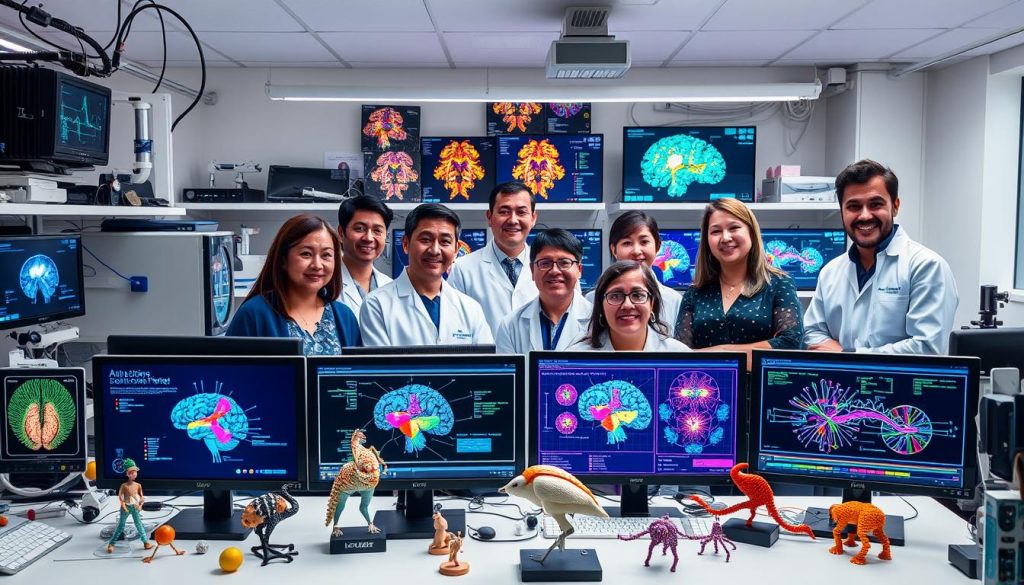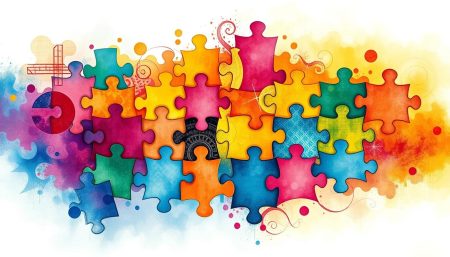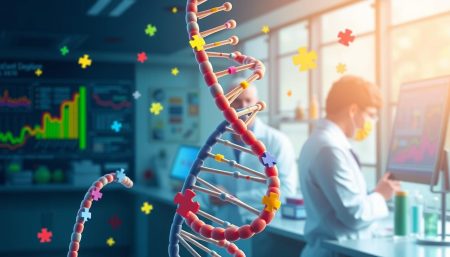The journey through the history of autism spectrum disorder (ASD) shows a complex story of growth. It moves from early misunderstandings to key discoveries. The autism timeline highlights a big change in how we see and treat this condition.
We start to explore the autism history and its key moments. These moments have shaped how we understand and help people with autism today. This story is not just about science; it’s about people and our growing understanding of each other.
Defining Autism Spectrum Disorder Through the Ages
Our understanding of Autism Spectrum Disorder (ASD) has changed a lot over time. At first, it was misunderstood. Now, we see how it was seen and labeled in medicine and society.
Early Concepts and Descriptions of ASD
There were signs of autism as far back as the 18th century. Old writings and medical texts talked about kids with behaviors we now call autism. These stories, even without the name ASD, showed kids who acted differently in social and communication ways.
Evolution of the Terminology and Classification
The word ‘autism’ was first used by Eugene Bleuler in 1911. He meant it for schizophrenia. But in the mid-1900s, Leo Kanner started seeing autism as its own condition. Over years, autism went from one idea to a wide range of conditions, showing how complex it is.
| Year | Definition | Classification |
|---|---|---|
| 1943 | Kanner’s early description of autism | Described as “early infantile autism” |
| 1980 | Entry in DSM-III | Categorized under Pervasive Developmental Disorder |
| 2013 | Updated in DSM-5 | Introduced the term “Autism Spectrum Disorder” encompassing all subtypes |
Changes in how we talk about autism have helped doctors diagnose it better. This has led to treatments that fit each person’s needs. This shift in language has also helped society understand and accept autism more.
History of Autism Spectrum Disorder: Key Milestones
The journey through ASD history is filled with pivotal moments in autism. These moments have greatly shaped how we understand and treat autism today. They are deeply connected to ongoing autism research. Looking back at these breakthroughs helps us see how our views and treatments have changed over time.
From the first clinical observations to today, each milestone has brought new insights and sometimes, big changes. Here are some of the most important moments:
- The first signs of autism were noticed in the early 20th century, starting the research journey.
- In the 1940s, the first diagnostic criteria were released. This helped professionals start diagnosing and understanding autism better.
- The 1980s and 1990s saw a big change. The definition of autism was broadened, leading to what we now call Autism Spectrum Disorder (ASD).
- At the start of the millennium, autism research grew. Studies focused on genetics and brain functions.
- Recently, there’s been a focus on early diagnosis and personalized treatments. This has changed the future for people with ASD.
Every pivotal moment in autism has added to our understanding of the spectrum. It has influenced education, therapy, and policy-making. The drive for more autism research continues, promising to bring even more insights and improve lives even more.
The Pioneers of Autism Research
Hans Asperger and Leo Kanner have made huge impacts on autism research. They each brought new ideas and observations that changed how we see and treat autism. Their work was the start of a big field of study.
Hans Asperger and Asperger Syndrome
Hans Asperger was an Austrian doctor who first talked about “autistic psychopathy” in 1944. He called it Asperger Syndrome later. It’s about trouble with social skills and communication, but these kids were smart and could talk.
Today, we know Asperger Syndrome is part of the autism spectrum. His work helps us understand this complex condition better.
Leo Kanner and Autism Discovery
Leo Kanner was a psychiatrist at Johns Hopkins Hospital. In 1943, he said autism was a unique brain condition. He described 11 kids with special challenges, like needing things the same way.
Kanner’s work was a big step. It showed autism was different from other problems and needed its own way of being diagnosed.
| Pioneer | Key Contributions | Impact on Autism Research |
|---|---|---|
| Hans Asperger | Identification of a form of autism later named Asperger Syndrome, highlighting social interaction and behavioral patterns. | Shifted understanding of autism spectrum, embracing a broader spectrum that includes higher functioning individuals. |
| Leo Kanner | First to describe autism as a distinct neurological condition with specific symptoms like echolalia and craving for sameness. | Laid the groundwork for the modern diagnostic criteria used to identify and treat autism spectrum disorders. |
The Evolving Perception of ASD in Society
Our understanding of autism spectrum disorder (ASD) has grown a lot. This change is thanks to the autism awareness timeline and how society views ASD. The media has played a big role in shaping these views.
From Misunderstanding to Awareness
The journey to understanding ASD has been slow but powerful. At first, there was a lot of stigma and wrong ideas. But, as more people learned and spoke out, things started to change.
Awareness campaigns and open talks have helped a lot. They’ve shown what it’s really like to live with autism.
Impact of Media and Pop Culture
The media’s impact on autism is huge. Movies, TV, and news have helped people understand and feel for those with ASD. Media can show the good and the hard parts of living with autism.
Media and pop culture show the ups and downs of autism. They help people see and talk about ASD in new ways. This shows how important it is for media to show autism accurately and with care.
Breakthroughs in Autism Research
The field of autism research has seen big autism research breakthroughs in recent years. These breakthroughs have greatly helped us understand and manage Autism Spectrum Disorder (ASD). They show how important advancements in ASD are, improving how we diagnose and treat it.
- Genomic Research: Finding genetic markers linked to ASD has opened new paths for research. This is key for creating targeted treatments, marking a major autism research breakthrough.
- Neuroimaging Techniques: New imaging tech lets researchers study autism in the brain. This helps in making treatments that target specific brain behaviors, showing big advancements in ASD.
- Early Detection Methods: New ways to screen for ASD early mean kids can start treatments sooner. This can greatly change their development, marking a big breakthrough.
- Technological Interventions: AI and machine learning are being used to make learning environments for ASD individuals. This technology helps improve their quality of life and learning.
These advancements in ASD have not only deepened our understanding of the disorder. They also bring real improvements to those affected. The mix of new research methods and tech keeps pushing autism care forward, making it more effective for the future.
A Timeline of Autism Awareness Initiatives
The growth of autism awareness shows how much we’ve learned and grown. Thanks to hard work, more people now understand and accept autism. This change has made a big difference over the years.
Establishing the First Autism Awareness Campaigns
Autism awareness started with small, local efforts. These early steps helped pave the way for bigger movements. Families and advocates used many ways to spread the word, from pamphlets to speeches.
National and International Recognition of ASD
As autism became more visible, so did its recognition worldwide. Governments and health groups started to see the need for support. This led to World Autism Awareness Day, celebrated to boost understanding and cooperation.
In summary, the path from early awareness to global recognition shows our progress. Yet, there’s more to do to support the autism community. With ongoing efforts, we can keep improving how society views and treats autism.
Historical Treatments and Therapies for Autism
The history of autism treatments shows a big change from bad conditions to better ones. This change has helped a lot in helping people with Autism Spectrum Disorder (ASD).
The Shift From Institutionalization to Specialized Care
In the early 1900s, people with autism were often locked away in asylums. These places were not good for them, focusing more on keeping them in than helping them. But, things changed over time. Now, we have better places for care that are kinder and more helpful.
Development of Behavioral and Educational Interventions
The start of behavioral interventions for ASD was a big step forward. Psychologists came up with ways like Applied Behavior Analysis (ABA). It uses rewards to teach good behaviors. Today, we have many ways to help, each one fitting the person’s needs.
Here’s a table showing how treatments have changed over time:
| Time Period | Treatment Approach | Key Characteristics |
|---|---|---|
| Early 20th Century | Institutionalization | Highly restrictive, limited personal interaction or development focus |
| Mid-20th Century | Introduction of Behavioral Therapies | Focus on behavior modification, early forms of ABA |
| Late 20th Century to Present | Specialized Educational Programs | Individualized educational plans (IEPs), inclusion in mainstream education |
The Role of Advocacy Groups in Shaping ASD History
ASD advocacy groups have played a huge role in changing how we understand and support autism. They have pushed for big changes in autism policies and education. Their work has made a big difference in how we treat and educate people with ASD.
Grassroots Movements and Their Legacy
Grassroots movements led by ASD advocacy groups have changed how we see autism. These movements started small but grew to change how society views and treats ASD. They helped bring people with ASD into schools and workplaces, a big change from the past.
Policy Changes and Educational Reforms
ASD advocacy groups have made a big impact on autism policies and education. They fought for laws that make schools more inclusive for people with ASD. Their work has led to big changes in how we support people with ASD in schools and health services.
| Year | Milestone | Impact |
|---|---|---|
| 1990 | Introduction of the Individuals with Disabilities Education Act (IDEA) | Guaranteed free and appropriate public education to children with disabilities, including those with ASD. |
| 2006 | Combating Autism Act | Allocated substantial federal funds for autism research and monitoring. |
| 2020 | Increased Federal Funding for ASD Services | Increased budget for services and resources for people with ASD, expanding access to technologies and support services. |
This table shows how advocacy leads to big changes in laws and education. It helps make sure people with ASD get the support they need.
Early Signs of Autism: Recognition Across Time
The history of spotting early signs of autism and recognition of ASD symptoms has changed a lot. It’s been shaped by science and society. At first, symptoms were seen through a narrow view, often missed or misunderstood. Now, we can spot them earlier and more accurately, thanks to better understanding and tools.
Back then, only severe cases were recognized. People with milder symptoms were often missed. Today, we use detailed checklists to catch a wide range of signs. This makes diagnosis more subtle and inclusive.
- Lack of joint attention development
- Minimal use of gestures for communication
- Limited interest in social play
These new ways of assessing autism help create personalized plans. They focus on each person’s strengths and challenges. This approach is key to understanding autism’s many forms, from mild to severe.
Now, we study developmental milestones closely. This helps us spot autism’s early signs. This shift has changed how we diagnose and support families early on.
The path from first noticing ASD symptoms to today has been long and complex. It’s marked by big changes in how we see and diagnose autism. Each step forward improves life and outcomes for those with autism.
Genetic Research and Autism: Unraveling the Enigma
Genetic research into autism has given us deep insights into Autism Spectrum Disorder (ASD). It helps us understand the genetic factors that might affect ASD. It also shows the chance for early diagnosis of ASD.
Pioneering Studies in Autism Genetics
Genetic research in autism has made big steps forward. Large-scale genome sequencing projects have found variations and mutations linked to autism. These findings offer hope for early intervention strategies. This could lead to better lives for those with ASD.
The Importance of Early Diagnosis and Intervention
Early diagnosis of ASD is key for effective treatment. Finding autism early allows for early therapy. This is vital for supporting growth and improving life quality. As research advances, we can refine diagnosis and tailor treatments better.
Here’s how genetic research affects ASD diagnosis and treatment:
| Aspect | Impact of Genetic Research |
|---|---|
| Diagnostic Precision | Genetic markers help diagnose ASD more accurately. This helps tell ASD apart from other developmental disorders. |
| Intervention Tailoring | Genetic insights lead to personalized treatment plans. These plans focus on the individual’s genetic needs. |
| Future Research Directions | It guides future studies on how genes and environment interact in ASD. |
Cultural Influence on Autism Recognition and Treatment
The cultural influence on autism greatly impacts how we see and treat autism spectrum disorder (ASD) worldwide. It’s key for doctors and teachers to grasp these cultural differences. They need to provide cross-cultural ASD treatment and support effectively.
In many places, autism is seen through the culture’s beliefs and values. This can change how we notice and deal with ASD. For example, some cultures value community over individualism. This can affect how they see and treat autism.
- Spotting early signs of autism varies a lot, with some cultures catching it sooner than others.
- Therapy and help for autism can differ based on local healthcare and what resources are available.
This shows why we need cross-cultural ASD treatment that fits with local customs and values.
- Teaching doctors about cultural differences in autism.
- Changing therapy to match local beliefs and practices.
- Getting communities involved in autism talks to understand it better and reduce shame.
It’s a big challenge for those working in this area. They must connect global autism standards with local ways. This ensures everyone gets the help they need.
Neurodiversity Movement: A New Chapter in Autism History
The neurodiversity movement has changed how we talk about autism spectrum disorders. It shows that neurological differences are something to be valued. This new view sees these differences as special parts of what makes us human.
The Emergence of Neurodiversity
The neurodiversity movement started in the late 1990s. It came from people who wanted to be seen as different, just like other groups. They wanted society to accept and support people with autism, seeing them as a natural part of human diversity.
The Impact on Acceptance and Inclusion
The neurodiversity movement has helped make society more accepting of autism. It has made a big difference in education, work, and social services. It shows that we should create places where people with autism can use their talents and ideas.
This change in autism history asks us to think differently about how we help people. We should focus on what they can do well, not just what they can’t. This approach makes communities better and brings new ideas to the table.
Thanks to the neurodiversity movement, we’re pushing for more acceptance and inclusion. These ideas are becoming part of how we live together. They show that having different brains is as important as having different cultures for our success and strength.
Myths and Misconceptions: How Knowledge of ASD Dispels Stigma
Autism spectrum disorder (ASD) has long been misunderstood, adding to the stigma around it. By sharing accurate info and raising awareness, we’re making progress. This progress helps create a more welcoming society for everyone.
One big challenge is fighting off ASD myths and misconceptions that are common. These myths can change how people with ASD are seen and treated in many places.
- Myth: ASD only affects children.
- Myth: Individuals with autism do not desire social interactions.
- Myth: ASD is caused by poor parenting.
Each of these myths is wrong and shows a lack of understanding about autism. By debunking these myths, we help reduce the stigma around dispelling autism stigma.
| Myth | Fact |
|---|---|
| ASD is a result of bad parenting. | Autism is a neurodevelopmental condition with no known single cause, but genetic factors play a key role. |
| People with autism are just acting out for attention. | Behaviors associated with autism are part of the individual’s neurotype and not a choice. |
| Autism can be cured with the right medicine or therapy. | While there is no cure for ASD, various therapies can help manage symptoms and improve function. |
By correcting these misconceptions and sharing accurate info, we can make a big difference. It’s important to educate everyone about the real facts of autism. This education helps create supportive environments and policies for people with ASD to thrive.
Global Perspectives on Autism Spectrum Disorders
In today’s world, understanding and managing autism spectrum disorders (ASD) is more important than ever. International research and studies across cultures are key. They help us see how different societies view and treat ASD, giving us valuable insights.
Cross-Cultural Studies on ASD Prevalence and Treatment
Research from around the world shows big differences in how ASD is seen and treated. These differences often show how societies view health and care. Studies across cultures reveal unique patterns and needs, and show how therapy varies by culture.
International Collaboration in Autism Research
Working together across borders has greatly expanded autism research. This teamwork helps us understand ASD better and develop better ways to help. By sharing knowledge and resources, we make big strides in finding new solutions.
| Country | Prevalence Rate | Preferred Treatment Approaches |
|---|---|---|
| USA | 1 in 54 | Behavioral Interventions, Speech Therapy |
| Japan | 1 in 125 | Integrated Education Programs, Parent Training |
| Brazil | 1 in 68 | Multi-disciplinary Approaches, Family Support Networks |
| India | 1 in 89 | Community-based Rehabilitation, Holistic Therapies |
Studies from around the world show us how to improve care for ASD. By learning from these studies, we can make care more sensitive and effective. This research helps us see both the differences and similarities in how ASD is viewed globally.
Modern Advances in Technology Aiding Autism Research
Technology has changed how we study autism, thanks to AI for ASD diagnosis and virtual reality therapy. These tools help doctors diagnose autism more accurately. They also offer new ways to treat autism that meet each person’s needs.
AI, Machine Learning, and ASD Diagnosis
AI and ASD diagnosis are now closely linked. Machine learning models use big data to spot autism in kids early. This tech makes diagnosing autism faster and more precise. It helps doctors create treatments that fit each person’s needs.
The Use of Virtual Reality in Autism Therapy
Virtual reality therapy is changing how we treat autism. VR creates safe, real-like worlds for practice. It helps people with autism work on social skills and handle sensory issues in a safe space. This approach looks promising for improving life and behavior for those with autism.

These tech advances in autism research lead to more tailored treatments. They also open doors for new ways to help people with autism in everyday life and learning. As AI and VR continue to evolve, we can expect even more breakthroughs in diagnosing and treating autism.
A Look to the Future: Emerging Trends in Autism Study
The world of autism study is always changing. Each year, we learn more and find new ways to help. The future looks bright with trends like personalized medicine and using technology like artificial intelligence.
These tools promise better ways to diagnose and teach people with autism. They could make a big difference in their lives. It’s exciting to think about how these new ideas will fit into what we already know.
Looking ahead, research will dive deeper into autism’s causes. This could lead to treatments that target specific problems. We also expect to see more support for people with autism in schools and jobs.
It’s important to understand and accept autism as we move forward. This means getting rid of wrong ideas about it. By doing this, we can create a society that welcomes and supports everyone, no matter their differences.
To support these changes, we need to see autism in a new light. A great place to start is here. It shows why we should view Autism Spectrum Disorder as a developmental issue, not just a mental health problem.
With ongoing research and teamwork, we can make a real difference. We can help people with autism live better lives. The future is full of hope and possibilities.
FAQ
Q: What is Autism Spectrum Disorder?
A: Autism Spectrum Disorder (ASD) is a complex condition. It affects how people interact, communicate, and behave. The term “spectrum” shows the wide range of strengths and challenges in ASD.
Q: When was Autism Spectrum Disorder first recognized?
A: ASD was first seen as a distinct condition in the mid-20th century. Leo Kanner and Hans Asperger were key figures. Kanner’s work came out in 1943, and Asperger’s in 1944.
Q: What were some early signs of autism recognized by researchers?
A: Early signs included trouble with social interactions and a need for sameness. People with autism often focus on repetitive activities. They also have unusual reactions to sensory stimuli.
Q: How has the definition of Autism Spectrum Disorder changed over time?
A: The definition of ASD has grown a lot. It started with a narrow set of symptoms. Now, it includes a wide range of conditions affecting communication and social interaction.
Q: What role have Hans Asperger and Leo Kanner played in autism research?
A: Hans Asperger and Leo Kanner were pioneers in autism research. They identified key behaviors and patterns. Their work helped shape our understanding of autism and Asperger Syndrome.
Q: How has societal perception of ASD evolved over the years?
A: Society’s view of ASD has changed a lot. It used to be misunderstood and stigmatized. Now, there’s more awareness and acceptance, thanks to advocacy and media.
Q: What are some of the most significant breakthroughs in autism research?
A: Big breakthroughs include finding genetic factors in ASD. There have been advances in early diagnosis and treatment. Behavioral therapies and early intervention have also shown benefits.
Q: What have been some historical treatments and therapies for autism?
A: Early treatments were varied and sometimes harmful. They included institutionalization and even LSD. Today, we focus on behavioral therapies and personalized education plans.
Q: How have advocacy groups impacted the recognition and treatment of ASD?
A: Advocacy groups have been key. They’ve raised awareness, funded research, and pushed for policy changes. Their efforts have improved education and rights for people with ASD.
Q: Why is genetic research important in the context of Autism Spectrum Disorder?
A: Genetic research is vital. It helps us understand ASD better. It leads to better diagnosis and tailored treatments for individuals with autism.
Q: In what ways does culture impact autism recognition and treatment?
A: Culture plays a big role. It shapes how we see and treat autism. Different cultures have different views and resources, affecting outcomes for people with ASD.
Q: What is the neurodiversity movement and how has it influenced autism history?
A: The neurodiversity movement celebrates neurological differences. It has changed autism history by promoting acceptance and inclusion. It celebrates diverse cognitive styles.
Q: How has increased knowledge about ASD helped dispel myths and stigma?
A: More knowledge has helped change public views. Research, media, and personal stories have shown the truth about autism. This has led to more empathy and support.
Q: What does global research reveal about Autism Spectrum Disorders?
A: Global research shows ASD is universal but treatment varies. International cooperation can standardize best practices. This can improve care worldwide.
Q: How is technology advancing the study and treatment of Autism Spectrum Disorder?
A: Technology is making a big difference. It includes AI for diagnosis, machine learning for treatment plans, and virtual reality for training. These tools help in many ways.
Q: What are some emerging trends in autism research?
A: New trends include studying the gut-brain connection and environmental influences. Genomics and personalized therapies are also being explored. These areas hold promise for future breakthroughs.


















